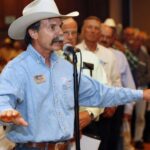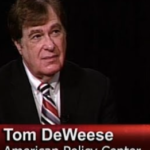 |
Pat Kopecki
Wilson County News
July 7, 2009 | Comment on this article
Agriculture leaders, as well as farmers and ranchers, are watching the outcome of the many congressional bills that are being discussed on Capitol Hill. They question whether farmers and ranchers will survive if additional permits and taxation are implemented. Two of the issues currently being discussed are the National Animal Identification System (NAIS) that is included in House Resolution (HR) 875, the Food Safety Modernization Act of 2009, and the probable taxation of cattle by means of changes in the Clean Air Act.
Those who have followed the NAIS controversy may have read editorials written by Henry Lamb, chairman of Sovereignty International Inc.
“The NAIS is an important part of controlling the rural population,” Lamb said.
Lamb, in a June e-mail interview, explained how NAIS opponents have linked the identification program to Agenda 21.
Lamb said, “NAIS is not a direct result of a specific recommendation set forth in Agenda 21. It is consistent, however, with the policy goals and recommendations of Agenda 21, in that the concept emerged from committees of the World Trade Organization, and was quickly incorporated into the ‘sustainable development’ concept which requires government planning and control.”
“NAIS will be devastating to small farmers, ranchers, homesteaders, and all livestock animal owners,” Lamb said. “The regulatory burden is economically unbearable, but this is only a symptom of the basic problem: NAIS ignores the Constitutional guarantees of privacy and security from an intrusive government (Fourth Amendment).”
Lamb has produced several videos on the NAIS issue and sustainable development, which can be found on Sovereignty’s Web site. In one, Lamb addresses how the government may enter private property, citing data from the American Planning Association publication titled, “Growing Smart Legislative Guidelines.”
“The model legislation contained in this book [“Growing Smart Legislative Guidelines”] provides many ways for government officials to enter private property and impose fines, and in some cases, actually ‘take’ private property without just compensation,” Lamb said. “One of the great concerns about NAIS is that once private property is registered in the program, no one knows what rights the federal government may have to the property. Since there is no law yet, nor any published regulations, no one can know what rights the USDA may claim. It is reasonable to conclude that they would claim the right to enter the property to ensure that animal counts and other information has been reported accurately,” Lamb said.
Lamb foresees that NAIS will aid in the implementation of the cattle gas tax being discussed under the proposed changes in the Clean Air Act because of the April 17 Environmental Protection Agency (EPA) finding regarding greenhouse gases.
“NAIS, if implemented, will give government absolute control over the production of all livestock products, not only by permits and punishment, but by direct taxation as well. With every livestock premises and every livestock animal tagged and reported to a government database, it would be a simple matter to levy a tax on every animal — such as the EPA’s recently proposed flatulence tax — and enforce collection of the tax by direct confiscation, if necessary,” Lamb said.
In another video regarding NAIS, Lamb mentions Kansas State University, which conducted the cost benefit analysis of the NAIS program. He identifies this university as the same university that received a grant for the establishment of an animal identification center. Lamb believes this “constitutes a conflict of interest.”
The public who closely watched the NAIS hearing sessions across the nation, including one in Austin, may have noticed how the government tried to use the consensus method.
In the video, “Sustainable America … A New Consensus,” Lamb explains that consensus is not an agreement, but the absence of an expressed opposition.
Lamb said that the USDA “set out to ‘listen’ to individuals in the morning, and hold break-out sessions in the afternoon conducted by trained facilitators to achieve ‘consensus’ around seven specific questions.
“We [the Sovereignty group] were able to inform and educate local grass-roots leaders in every city as to how to avoid the ‘consensus’ process and take control over the meetings. These folks were extremely successful and completely overwhelmed the USDA,” Lamb said.
Lamb warns the public in a March 14 press release titled, “Lawmakers trash the Constitution,” that the government will make NAIS mandatory through HR 875 or a similar bill.



